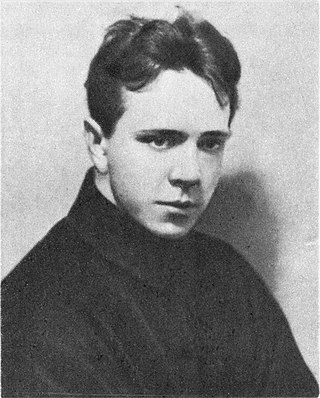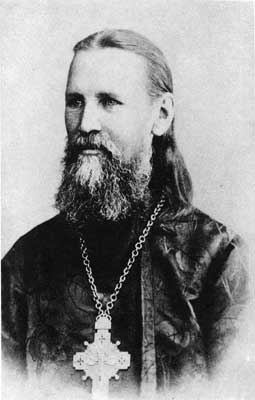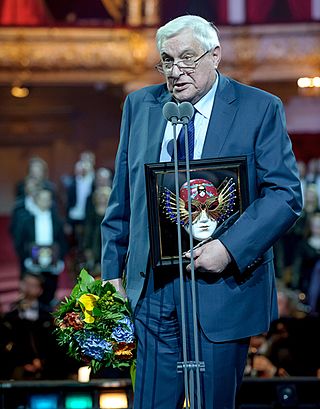
Dmitri Ivanovich Mendeleev was a Russian chemist and inventor. He is best known for formulating the Periodic Law and creating a version of the periodic table of elements. He used the Periodic Law not only to correct the then-accepted properties of some known elements, such as the valence and atomic weight of uranium, but also to predict the properties of three elements that were yet to be discovered.

Mikhail Aleksandrovich Chekhov, known as Michael Chekhov, was a Russian-American actor, director, author, and theatre practitioner. He was a nephew of the playwright Anton Chekhov and a student of Konstantin Stanislavski. Stanislavski referred to him as his most brilliant student.

Louis Adolf Peter, 1st Prince of Sayn-Wittgenstein-Ludwigsburg-Berleburg, better known as Peter Wittgenstein in English, was a prince of the German dynasty of Sayn-Wittgenstein and field marshal in the Imperial Russian Army during the Napoleonic Wars. He was nicknamed the Saviour of Saint-Petersburg.

Prince Pyotr Andreyevich Vyazemsky was a Russian Imperial poet, a leading personality of the Golden Age of Russian poetry.

John of Kronstadt or John Iliytch Sergieff was a Russian Orthodox archpriest and a member of the Most Holy Synod of the Russian Orthodox Church. He was known for his mass confessions, numerous miracles, and charitable work, as well as his monarchistic, chauvinistic and anti-communist views.
Mikhail Alexeyevich Matinsky was a Russian scientist, dramatist, librettist and opera composer.

The Battle of Klyastitsy, also called the Battle of Yakubovo or the Battle of Oboiarszina, was a series of military engagements that took place on 30 July–1 August 1812 near the village of Klyastitsy on the road between Polotsk and Sebezh. In this battle, the Russian vanguard under the command of Yakov Kulnev and the whole corps of Peter Wittgenstein stood up to the French corps under the command of Marshal Nicolas Oudinot with heavy losses on both sides. The result was a Russian victory, their forces managing to capture the disputed village of Klyastitsy. The main strategic outcome of the battle was that the French offensive on St. Petersburg was stopped. The French partially retreated along their communication lines after the battle, and fended off Russian pursuers.

Oleg Valerianovich Basilashvili is a Soviet and Russian stage and film actor. He was awarded People's Artist of the USSR in 1984.
L. Tolstoy and Dostoyevsky was a literary essay written by Dmitry Merezhkovsky and published between 1900 and 1901 in Mir Iskusstva magazine. The essay explored a comparison between the creativity and worldview of Leo Tolstoy and that of Fyodor Dostoevsky. The author worked on his research from 1898 to 1902 and its publication coincided with Leo Tolstoy's excommunication by Most Holy Synod and drew wide public response. L. Tolstoy and Dostoyevsky is considered the most significant work of Merezhkovsky in the genre of literary research and was subsequently recognized as the most detailed and accurate study of Leo Tolstoy's work.
Vladimir Nikolayevich Myasishchev was a Soviet psychiatrist and developmental psychologist.
Mikhail Pavlovich Bobyshov was a Soviet Russian painter and stage decorator, People's Artist of the Russian Federation, Honored Art worker of the Russian Federation, professor of the Repin Institute of Arts.
Baykov Leonid Petrovich was a Russian and Soviet painter, a member of the Leningrad Union of Soviet Artists, who lived and worked in Saint Petersburg, regarded as one of representatives of the Leningrad School of Painting. Participated in exhibitions since 1943. Important exhibitions: "All-Union Art Exhibition", Moscow, 1951.

Lev Konstantinovich Bogomolets was a Soviet Russian painter, a member of the Saint Petersburg Union of Artists, who lived and worked in Saint Petersburg, regarded as one of representatives of the Leningrad school of painting, most famous for his landscape paintings.

Freemasonry in Russia started in the 18th century and has continued to the present day. Russian Freemasonry pursue humanistic and educational purposes, but more attention is given to ethical issues. It was a spiritual community of people united in an effort to contribute to the prosperity of the Motherland and the enlightenment of the people living in it.

Pyotr Pavlovich Albedinsky (1826–1883) was a Russian military officer and politician.

Alexei Arbuzov (1792–1861) was an Imperial Russian general of the infantry and division commander. He fought in wars against the First French Empire and the Ottoman Empire. He took part in suppressing the uprising in Poland. He was the maternal grandfather of Nikolai Velyaminov and Natalia Nordman.

Gavriil Nikolayevich Zhulev was a Russian satirical poet, dramatist and actor.

"The Runaway" is an 1887 short story by Anton Chekhov.

"The Cattle-Dealers" is an 1887 short story by Anton Chekhov.
The Komi language, a Uralic language spoken in the north-eastern part of European Russia, has been written in several different alphabets. Currently, Komi writing uses letters from the Cyrillic script. There have been five distinct stages in the history of Komi writing:














